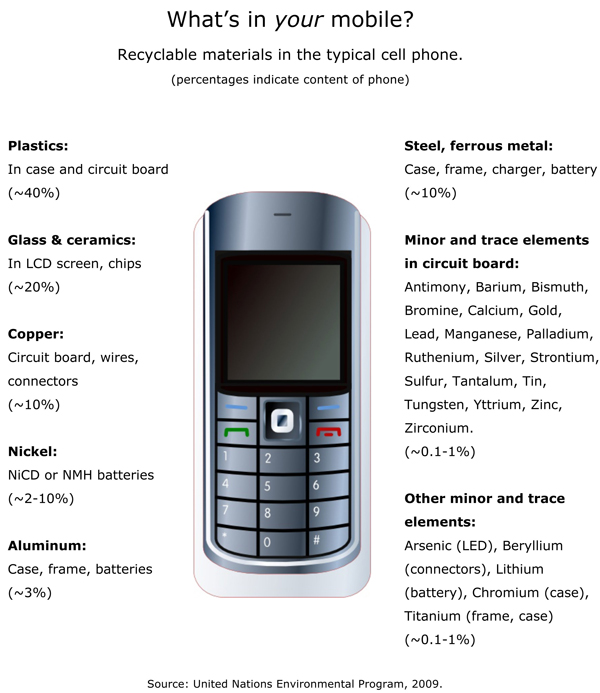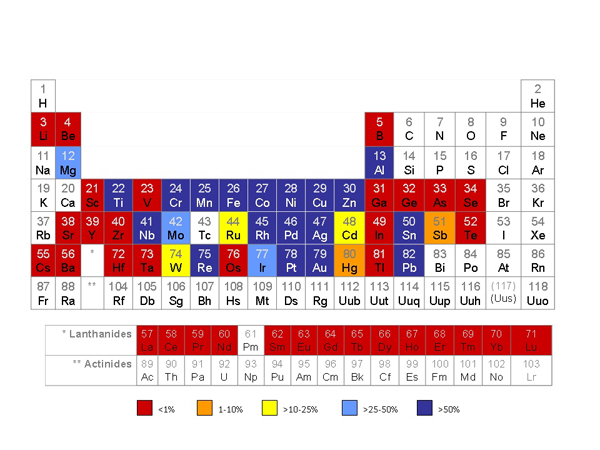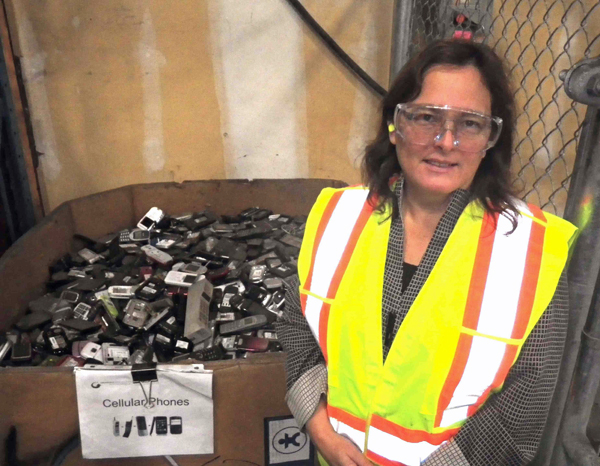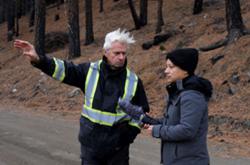[Editor's note: Every day this week we featured reports from Christopher Pollon's quest to follow a pound of B.C. copper from cradle to grave -- and back again. Today, we're in the grave and at the end of the series. To get a sense of the scope of the project, see this interactive map, above. The map also links to previous stories in this series.]
LANGLEY, B.C. -- Not long ago this industrial park was farmland: now it's home to a virtual mine harvesting metal, plastic and glass from all the electronics British Columbians throw away.
For anyone who has ever disposed of a cell phone, hair dryer or appliance at a B.C. drop-off box, this is where some of it goes: a graveyard of sorts, where "end-of-life" products take the first step toward life anew. In any given month, a million pounds of "e-waste" comes through this plant alone.
Cindy Coutts is the President of Sims Canada, a subsidiary of the biggest urban "mining" company on earth. Walking through the Walmart-sized plant (which will double to 60,000 square feet this year), she grabs a printed circuit board the size of a coffee table book and holds it up. Gold and copper gleam against a green backing.
"Smelters love this," she says. "This board is higher grade copper and gold than ore you would dig out of the ground, and requires 80 per cent less energy than virgin metal to refine."
While an open pit mine might harvest a single metal with trace amounts of others, this urban mother lode contains more than 25 separate globally-traded commodity streams. The real business for a company like Sims is to figure out where all 25 materials need to go -- other than a landfill. And as Coutts makes clear, it's not just Sims' job to figure all of that out.
"As a society, we haven't gotten our heads around the idea that consumer products need to be managed at end of life too," she says. "Right now, I'm a bit cynical. Joe just wants to go to Best Buy and pick up a cheap TV."
Resurrecting cell phones
Coutts leads me to a box containing thousands of cell phones -- a mosaic of every colour, size and age, from recent iPhones to early commercial models from the mid-1990s. One prehistoric Motorola, including uncollapsable antennae, stretches from my elbow to finger tips, weighing about five pounds.
Sims is one of five companies currently contracted by Recycle My Cell, a not-for-profit created by wireless manufacturers and service providers to recycle phones and other electronic devices across Canada. This is the end of the road for phones and other appliances; nothing here will be reused as-is. After any battery is removed, they will be shredded into small chunks to enable the separation of materials -- including glass, aluminum, plastic, and copper. The fragments are then sorted with magnets and other technologies to further separate ferrous from non-ferrous metals.
"The life cycle continues when we ship it to one of eight global smelters," says Coutts, who says there are currently just this many big corporate smelters capable of refining the copper and precious metals contained in a cell phone.
One of these is the Teck smelter at Trail B.C. Another is Mitsubishi Material Corporation's Naoshima Island smelter near Osaka, Japan -- the same place where a lot of virgin ore from B.C.'s Copper Mountain, Huckleberry, and Highland Valley copper mines is also smelted.
Sims is a big enough recycler that it can deal with smelters directly, Coutts says, as opposed to selling to brokers who might ship the shredded phones to untraceable, environmentally dangerous small-scale recycling operations (the epicentre of such well-documented operations is Guiyu China). "If we send material to a smelter we want to make sure the smelter is operating to a certain set of standards," she says.
A global glut of disposable gadgets
One of the biggest challenges in recycling metals like copper is that so much of it is locked up in use for decades at a time -- in the copper water pipes in your home or the wiring of cars sitting in scrap-yards. But for cell phones, and a growing volume of other disposable electronics, this supply-lag is not an issue.
The average life span of a cell phone is now about one year; for a laptop, just two to three years. UN researchers predict that by 2017, the total annual volume of used electronics on earth (~60 million tonnes) will weigh as much as 200 Empire State Buildings, or about the same as 11 Great Pyramids of Giza.
Copper accounts for about 10 per cent of the weight of a modern smartphone (including copper found in the printed circuit board, wires, connectors, transformer and battery). Sometime this year the number of cell phones on the planet will surpass the number of people. By then, cell-phone owners will be carrying around nearly 260 million pounds of copper, worth over $830 million at today's prices.
'Can we still have an iPhone in 30 years?'
The global end-of-life recycling rate for copper of about 45 per cent, as low as it sounds, is considered a success story.
A modern smartphone contains more than 60 elements, including anywhere from 40 to 50 different types of common and exotic metals. For at least 30 of these, no end-of-life recycling exists at all. Many of the latter are so-called "rare earth" metals, used in tiny amounts. As the name suggests, many are in short global supply, or must be sourced from volatile, politically unstable places in the world.

While elements like copper, nickel and lead are easily identifiable, used in large quantities, and have long-established infrastructure and technology for recycling, many of the newer materials do not.
"If one of these metals are no longer available for any number of reasons, can we still have an iPhone in 30 years?" wonders Barbara Reck, a research scientist and metals expert at Yale University's School of Forestry and Environmental Studies. "Or will we all be back to our very simple phones of the past because simply there won't be enough rare earth metals?"
Environment vs. marketing
Pressure to increase functionality and minimize the use of rare materials means that smaller amounts of everything from copper to tantalum are being dispersed more widely into consumer products than ever before. "Generally there is a trend in [electronic] product design that actually makes recycling more difficult than it used to be in the past," says Reck.
Its very size and relative lack of sophistication made it easier to recycle the metals from that 1997 monstrosity of a Motorola phone I saw in Langley (or an automobile of the same year) than from their successors manufactured today. Considering that we live in a world of increasingly scarce and hard-to-get-to resources, that could seem like moving backwards.
What's changed? Reck says that today virtually all the stable elements found on earth are put to use for their various unique physical and chemical properties. In products like electronics, that's resulted in functionality that past generations could only dream of, but it has also made recycling much more complicated.
Designing products with easier recycling in mind could be a huge part of the solution. The problem with that, says Sean Magann, VP of Sales and Marketing at Sims Recycling Solutions, is that environmental design considerations are always subservient to marketing. He gives the example of a designer attempting to create a smartphone that minimizes the number of different coloured plastics, which are notoriously hard to separate and recycle.
"People buy things on the basis of aesthetics. Every single time, who do you think is going to win, the environment or the marketing department saying you can sell more widgets if you use two colours of plastic?"
The lowest price is the law
End users also demand low prices. Producers, manufacturers and retailers respond. In spite of the many finite resources our phones rely on to function -- from copper and gold, to tantalum and cobalt -- they are marketed and consumed as disposable products.
In the U.S., Walmart unveiled plans in August 2013, to drop the price of an iPhone 5 to $98, in anticipation of Apple launching its next generation iPhone the following month. Timed to that launch, Apple itself extended a buyback program designed to encourage anyone with an older iPhone to trade it in on the latest model. If your old phone couldn't be reused, Apple promised to "recycle it responsibly for you."
But "responsibly" isn"t the same thing as "completely." Apple's efforts to improve its environmental performance notwithstanding, no one on Earth can currently claim to fully recycle a modern cell phone. We could come closer, Cindy Coutts says, but the "recycling fee" we pay at the cash register would likely at least quadruple -- a hard sell to buyers who demand the lowest price.
"We can recycle it, or we can wait until resources become scarce and our planet's in crisis," she adds.
A recycling society by necessity?
Japan got a foretaste of just that pending crisis in 2010, when China restricted exports of the 90 per cent of the world's rare earth supply that comes from its territory. The move has forced Japan, led by companies like Honda and Toyota, to become a global leader in new technologies to recycle and reuse these metals. Today there is a smelter in Japan that can recover 15 of the 30 or so most exotic elements, but there are still at least as many that even it cannot recapture. In a 2013 article in Science, Barbara Reek warned that nothing short of international mobilization was needed to combat our resource myopia.

"The situation clearly calls for international policy initiatives to minimize the seemingly bizarre situation of spending large amounts of technology, time, energy and money to acquire scarce metals from the mines, and then throwing them away after a single use."
The monumental global disconnect
Copper is an essential ingredient in virtually all the disposable devices that make our 21st century comfort possible, and hence embodies our dysfunctional relationship with most everything we consume.
In British Columbia, we occupy only the first and final stages of the copper supply chain, as miners and end consumers. As the example of a cell phone made with B.C. copper illustrates, our role is limited to digging copper out of the earth, sending it away to be returned to us in some gadget or necessity, that we then use briefly and throw away.
When I started this series, I began with a simple observation: nobody here, or anywhere in B.C. as far as I could tell, seemed to know or care what happened to all our copper once it's loaded onto a ship.
It turns out we're not alone. Beginning in 2008, Yale University's Barbara Reck participated in an ambitious project to evaluate the "criticality" of the Earth's metals -- to determine which would run out in the future, and what could be done proactively to adapt to future resource scarcity. What made the project so daunting was the discovery that every step of the metals supply chain, from mining to end consumption, occurred in complete ignorance of every other step.
"We've talked to specialists who really know everything about their particular niche, but they have no idea of what exactly happens in manufacturing, where it ends up after trade, or where the end-users are," Reck says. "And for sure, they have no idea about all the complexities of recycling."
This monumental global disconnect thwarts any serious attempt to maximize the use and recovery of valuable and increasingly scarce finite materials.
But there is hope, and it comes from Asia. In following the supply chain of B.C. copper through the world, the biggest revelation has been that our "trash" is, particularly in Chinese eyes, valuable raw material. And that includes so-called "e-waste."
It took a crisis in rare earth metal supply to force Japan to think differently about what they throw away. For the Chinese, the metal, paper and plastics discarded by wealthy nations fill the holds of China-bound ships that, after dropping off manufactured goods here, would otherwise return empty.
For our part in B.C., we sell our raw copper to Asia, buy it back as mostly disposable finished goods and, perhaps half of the time, send it back to start all over again. ![]()
Read more: Energy, Labour + Industry


















Tyee Commenting Guidelines
Comments that violate guidelines risk being deleted, and violations may result in a temporary or permanent user ban. Maintain the spirit of good conversation to stay in the discussion.
*Please note The Tyee is not a forum for spreading misinformation about COVID-19, denying its existence or minimizing its risk to public health.
Do:
Do not: